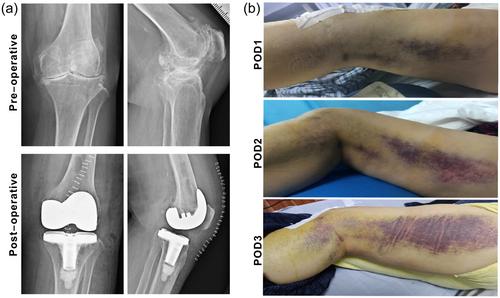Personalized delayed anticoagulation therapy alleviates postoperative bleeding in total knee arthroplasty (TKA) patients
Abstract
Purpose
Ecchymosis is one of the most common complications following total knee arthroplasty (TKA), which is closely related to postoperative bleeding. However, it is still controversial whether anticoagulation treatment should be continued for postoperative ecchymosis patients. We suppose that personalized delayed anticoagulation therapy could be beneficial for decreasing postoperative bleeding.
Methods
A total of 201 TKA patients were retrospectively included in this study, among whom ecchymosis patients received drug anticoagulation treatment 1–2 days later than usual, while nonecchymosis patients received regular drug anticoagulation treatment. The perioperative blood loss, coagulation state, fibrinolytic state and complications were collected and analyzed.
Results
Eighty-nine patients (44.3%) developed ecchymosis within 3 days after TKA. There were no differences in baseline characteristics between the two groups. In the ecchymosis group, higher K values and lower calculated coagulation index values were observed in thromboelastography, along with greater total blood loss and a more significant decrease in haemoglobin levels on postoperative Day 1 (POD1) compared to the nonecchymosis group. Additionally, the ecchymosis patients exhibited higher levels of fibrinogen degradation products and D-dimer (D-D) on POD1, with no differences noted on POD3, indicating that patients with ecchymosis are in a relatively hypocoagulable and hyperfibrinolytic state compared to those without ecchymosis. Therefore, the delayed anticoagulation treatment proved beneficial for correcting these postoperative conditions. No statistically significant differences were found between the two groups in postoperative complications, demonstrating that delayed anticoagulation treatment is safe.
Conclusion
Patients with ecchymosis exhibited a relatively hypocoagulable and hyperfibrinolytic state with a stronger tendency for postoperative bleeding. Delayed anticoagulation in ecchymosis patients could effectively prevent further exacerbation of postoperative bleeding by avoiding sustained hypocoagulable and hyperfibrinolysis states. Personalized delayed anticoagulation therapy could be beneficial for managing postoperative ecchymosis for TKA patients.
Level of Evidence
Level IV.


 求助内容:
求助内容: 应助结果提醒方式:
应助结果提醒方式:


